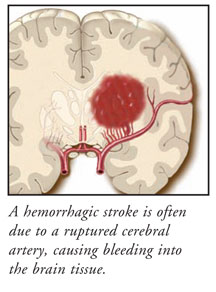 Lack of Blood to the Brain
Lack of Blood to the Brain
A stroke occurs when blood is unable to circulate freely through the brain. When brain cells are deprived of oxygen, they begin to die. Stroke is a serious, life-threatening situation that must be treated promptly to avoid permanent disability.
There are two kinds of strokes: ischemic and hemorrhagic. Ischemic strokes are by far the most common, causing over three fourths of all strokes. These strokes are caused by a blockage in a blood vessel in the brain, shutting off circulation to the brain cells in the area. Hemorrhagic strokes account for the remainder (about 20%) of strokes. This type is caused by bleeding into the brain tissue when a blood vessel in the brain breaks. The brain cells around the hemorrhaged area die, resulting in the symptoms of a stroke.
Since the brain controls much of the body’s functions, a stroke in the brain leads to a wide variety of symptoms, including pain, numbness, loss of balance, confusion, paralysis, and difficulty thinking, seeing, or speaking.
“Clot-buster” drugs, which dissolve the areas of blockage in a blood vessel, can be used within the first three hours of symptoms to speed recovery and prevent long-term disability. Therefore, a patient suffering from a stroke must reach the hospital within 60 minutes of the beginning of symptoms to be evaluated, diagnosed, and treated. When a person suddenly complains of the symptoms of a stroke, a call to 911 must not be delayed.
Rapid Treatment Is Vital for Recovery
Stroke is the third-leading cause of death, accounting for more than 150,000 deaths annually. Stroke causes serious disability and heavily impacts the quality of life for its sufferers. Knowing these facts can help people understand the importance of seeking medical treatment at the first sign of symptoms.
Risk Factors and Warning Signs:
An elevated risk for stroke exists if there is a history of stroke in a member of the immediate family. Risk also increases with older age, cigarette smoking, diabetes, high blood pressure, high cholesterol, and obesity. There is a greater risk in people who have heart disease or who have already suffered a stroke. Women taking birth control pills are at greater risk, and African-Americans have a higher risk, partly because they have a higher risk of high blood pressure and diabetes. Although many risk factors are not controllable, some can be lowered by following a healthy lifestyle.
Transient ischemic attack (TIA) is a warning sign, as well as risk factor, for future stroke. A TIA is sometimes called a “mini-stroke,” since it is caused by a temporary blockage of an artery in the brain, which then reverses itself within a short period. Symptoms are similar to those of a fullblown stroke except that they disappear quickly, usually within a few minutes. The other difference between a TIA and a stroke is that there is no permanent damage to brain cells after a TIA. Symptoms of a TIA should prompt a doctor’s visit for a full physical exam and assessment of the risk for a future stroke. In half of TIA cases, a full-blown stroke will follow within 12 months.
Symptoms:
The classic symptoms of a stroke include numbness, weakness, or even paralysis in an arm, a leg, or the face, often affecting only one side of the body. This may be accompanied by dizziness or a loss of coordination. Patients suffering from a stroke may have trouble seeing, speaking, or understanding another person speaking. In some patients, a stroke may cause severe headache, vomiting, a stiff neck, or loss of consciousness. The symptoms people experience have one thing in common: They start abruptly, without warning.
Diagnosis:
Rapid diagnosis of a stroke is important so that treatment can be started quickly. Testing includes a thorough physical exam and blood tests. Ultrasound imaging of the neck arteries can determine if there is blockage in blood flow to the brain. Special x-rays can be taken using injectable dye that allows the doctor to see the blood vessels that lead to and circulate in the brain.
Prevention and Treatment:
The critical factor in successful treatment of stroke is reaching medical assistance rapidly; the faster the diagnosis and treatment begin, the better the chance for a full recovery. In the case of ischemic strokes, the blockage must be removed from the blood vessel involved. A clot-busting drug known as tPA can rapidly dissolve the blockage and allow the circulation to be restored, but it must be used within three hours of the beginning of stroke symptoms, and there are risks to this therapy. Clot-busters should not be used in certain patients (such as those with very high blood pressure) or to treat hemorrhagic strokes, which could become worse with these drugs. In some cases of ischemic stroke, surgery to remove the blockages in an artery is a better treatment than clot-buster drugs. In strokes caused by bleeding blood vessels, surgery may be used to treat bleeding or prevent future bleeding.
Strokes can be prevented by reducing a person’s risk with healthy lifestyle changes and by seeking treatment after TIAs. Lifestyle changes include stopping cigarette smoking, lowering cholesterol levels, and maintaining a healthy weight through diet and exercise. Once a patient has suffered a stroke, antiplatelet medications that cut down on blood clotting can be used to prevent future clots. Some stroke patients with cardiac disease will require treatment with blood thinners to reduce their risk of future strokes.






